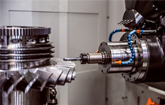BOSTON, May 16, 2018 /PRNewswire/ -- Within the field of 3D printing, there is increasing emphasis on functionality as the industry shifts away from the stereotype of rapid prototyping, and materials are not exempt from such scrutiny. For instance, within the field of metal additive manufacturing, metals such as titanium with excellent tensile strength and low density are ideal for lightweighting applications, and as such demand for these materials is continually increasing. Looking towards the field of polymer additive manufacturing and we can observe a similar trend: thermoplastics with a high Young's modulus, thermal resistivity or tensile strength are increasingly attractive. Although utilisation of these materials has been tempered to date, this is to an extent a product of the inability of most additive manufacturing hardware systems to reliably print such high temperature, functional polymers. For instance, Fused Filament Fabrication (FFF) has been limited by nozzle temperature and the temperature of the build plate and envelope.
PEEK and ULTEM are two such high temperature functional thermoplastics that offer high thermal resistivity up to 350 °C for short time frames, chemical resistance and wear characteristics, and low density. Such characteristics render both PEEK and ULTEM ideal for application in the aerospace industries due to their lightweighting potential. For instance, noncritical legacy parts which have been manufactured from aluminium may no longer be in production. In this case reverse engineering and additively manufacturing a component with a strong, lightweight material such as ULTEM becomes an ideal cost-effective solution to creating a one-off component. PEEK offers even higher thermal resistivity than ULTEM, in addition to reduced hygroscopicity and higher tensile strength as well as being bioinert. As such, PEEK is also suitable for application to the aerospace industry, but because of its biocompatibility, has now seen application as coatings for custom orthopaedic implants.
Until now, a combination of price and technical barriers have reduced appetite for these thermoplastics. In terms of price, ULTEM is manufactured exclusively by Sabic, and as such users have little choice to accept the market value, but as PEEK is manufactured by a range of formulators, end users can shop around for the best deal. However, even with greater consumer choice, PEEK filaments cost upwards of $700-1000 per kg. Nonetheless, the technical barriers that once precluded the use of these high temperature thermoplastics on Fused Filament Fabrication printers are being addressed. Previously the preserve of the Stratasys Fortus line, ULTEM and PEEK can now be reliably extruded on a range of new printers that have been commercialised since 2015. Of these, the INTAMSYS Funmat HT stands above the rest with a very affordable price point of $5,000 per printer. With new printers coming to market over the next year, the benefits of ULTEM and PEEK look set to be enjoyed by a much broader audience than before.
Learn more about 3D printing of ULTEM and PEEK in IDTechEx's new report: 3D Printing Materials 2018-2028: Technology and Market Analysis.
Contact
Charlotte Martin
Marketing & Research Co-ordinator
+44(0)1223 810286
[email protected]
SOURCE IDTechEx
WANT YOUR COMPANY'S NEWS FEATURED ON PRNEWSWIRE.COM?
Newsrooms &
Influencers
Digital Media
Outlets
Journalists
Opted In





Share this article